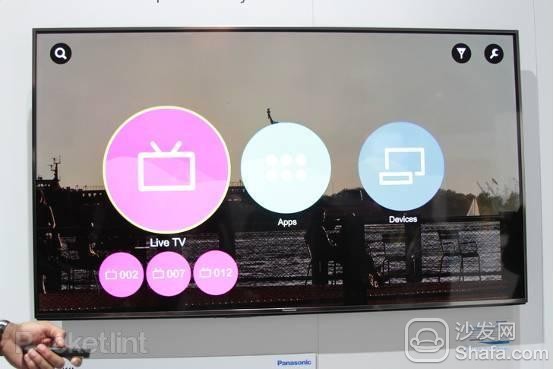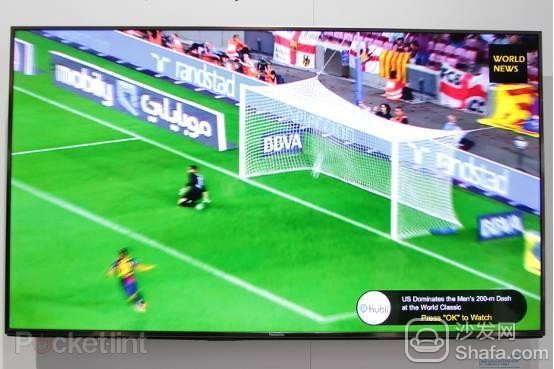
Android TV, Samsung Tizen, Firefox OS, and LG's WebOS, these systems are becoming more and more intelligent, more and more simple, but also make consumers interested in smart TV feel overwhelming. Now, the technology website pocket-lint compares these four smart TV platforms to see what their respective advantages and disadvantages are, and which one is best suited to different users. Let's take a look at it below.
Android TV
Android TV is the successor to Google TV. It is a system specially designed by Google for television and streaming media platforms. Android TV was officially launched in October last year and was first installed in set-top boxes such as Asus and Nexus Player. At the CES, Sharp and Philips both launched the first smart TVs with built-in Android TV platforms.
User Interface

Android TV is very easy to use, user interface is simple. As soon as you turn on your TV or set-top box, you will see the home or home screen.
The second line on the home screen is usually a list of all applications and games, and on the second screen is a continuous setting area. Here you will see movies, games and music on Google Play. It also includes additional downloads of third-party applications, including Netflix, Crackle, and Hulu Plus. Which one you need to click on.
voice search

The Android TV platform supports voice command control and can be operated as long as your TV hardware supports it. Voice search requires the user's TV remote control built-in microphone. Such as the Sony One-Flick remote control products.
In addition, Android TV's voice search not only supports simple video or game title search, but also supports more complicated commands. For example, "All Oscar-winning movies", Android TV can also filter out content on video sites such as Netflix and Hulu.
All the screening results will be presented in the form of cards below, including the starring information, the source of the video site, whether or not the fee is charged, etc.
Chromecast

The coolest feature of Android TV is its own Chromecast feature. Previously, if you wanted to synchronize the screen of your laptop or mobile device to your TV, you would need to spend $35 to buy Google Chromecast TV sticks, and Android TV's own Chromecast feature can do this directly. Even without the limitations of the Chrome browser, you can sync music or movie screens directly to the screen.
Tizen
The Tizen system is a new operating system developed by Samsung and built on the Linux kernel. The system is suitable for a variety of platforms, including smart TVs, smart phones, tablet computers, car entertainment systems, smart cameras, wearable devices, Blu-ray players, and even home appliances.
At this CES, Samsung officially announced a smart TV with a built-in Tizen system, which is also the first smart TV product equipped with this system.
User Interface

Remote control requires gesture operation. At the same time, the cursor will appear on the screen, and the corresponding function can be selected on the screen. At the top of the screen is the menu, the bottom is the smart option, the left is the volume, and the right is the channel selection.
On the home screen is what Samsung calls the Smart Hub. There is also a control button on the remote control. In fact, the Smart Hub exists in the form of a Dock, and its colors are very bright, with various icons on it. You can use the remote control as a controller to scroll between the Dock icons. If you do not like to use the remote control, you can also use voice commands (through the microphone on the remote control) or physical buttons in the left and right direction.
content

Recent apps in the Smart Hub show recently used apps and channels, as well as more Samsung partner content displays. The Tizen system features the App Store, game store, Samsung's Milk service, global search, web browser, notification center, and third-party applications, including MGo, PlayStation Now, and Amazon Instant Video.
It is unclear whether the icons of the Tizen system can be deleted or reordered. However, on the demo we see icons similar to trash cans, so deleting watch records should be possible.
Firefox OS (My Home Screen 2.0)
The famous Firefox system comes from Mozilla. It is also an operating system based on the Linux kernel. It already supports smartphones and tablets. Now it is on smart TVs.
At this year's CES, Panasonic displayed the modified Firefox OS interface and named it My Home Screen 2.0. Although the new system is still based on Firefox, it looks completely different from before.
User Interface

Users also need to use the remote control to select different content. In "Live TV", a row of channels that are also circular will pop up under the wish icon. The other two options are also in the same form, showing a list of applications and devices to manage an installed application or an external Blu-ray player.
In addition to the three default icons, the user can directly add frequently used programs to the main interface, and then select directly through the remote control. The user can even add a notebook or favorite channel to the home screen while performing voice operations via a navigation button or a microphone.
The voice search of Firefox OS can not only display the results from third-party platforms such as YouTube, but also include the content of external USB devices and Web browsers.
content

Notification Center

When we click OK, a specific notification message opens. Panasonic promised that the new system can easily switch back and forth between different applications.
LG WebOS 2.0
LG officially announced a new generation of WebOS 2.0 system at this CES, and said that it will be used in TV new products in 2015. The initial WebOS system was Palm and was used as a smartphone platform. It was subsequently sold to LG, which made its debut as a smart TV system in 2014.
Operation interface

Just start LG's WebOS system, you will see a very eye-catching startup Dock at the bottom, which shows recently used applications, channels, services and input devices. The new system adds the "My Channel" option that allows users to tag their favorite content.
In addition to supporting gesture operations and hands, LG's remote control can also perform many additional functions, such as connecting a set-top box via a built-in tuner. In addition, LG also added a quick setup feature to control other input sources while watching TV. The popup interface will overlap on the right side of the screen.
content

In terms of movie and TV interface presentations, LG is optimized for detail, while the previous viewing history can be seen through the quick access menu.
At the top of the WebOS 2.0 system, it also added quick access to homepages, movies, and games. It also included subscriptions to Netflix or Amazon Instant Prime Video.
to sum up

In the past, no one would care about the internal operating system for consumers who purchased TV. However, all this will change from 2015. Television has become more and more intelligent, so providing users with favorite applications and content becomes the key.
Android TV appears to us to be a great leader, providing all content on Google Play, whether it be music, movies or games, including third-party content from Netflix and YouTube.
Although the Samsung Tizen system also promises to bring rich video platform support, it is not currently available. This means that Samsung needs to encourage developers to develop more application support for Tizen systems. At present, Samsung said that there are already hundreds of Tizen applications that will be announced soon. At the same time, such open source platforms including Firefox will also have a large number of applications in the future.
Since LG’s WebOS has been developing for a year since last year, it currently has many partners and paves the way for future development. However, to be honest, currently Android TV looks more game-oriented overall.
In 2015, how these new TV platforms will develop and how they will develop will be worth our looking forward to. I believe that in the next year's summary, there will be different situations between each other.
Recommended installation sofa butler, download address: http://app.shafa.com/

